Assyrian/Chaldean/Syriac vs Zimbabwean Community Comparison
COMPARE
Assyrian/Chaldean/Syriac
Zimbabwean
Social Comparison
Social Comparison
Assyrians/Chaldeans/Syriacs
Zimbabweans
7,301
SOCIAL INDEX
70.5/ 100
SOCIAL RATING
124th/ 347
SOCIAL RANK
9,358
SOCIAL INDEX
91.0/ 100
SOCIAL RATING
18th/ 347
SOCIAL RANK
Zimbabwean Integration in Assyrian/Chaldean/Syriac Communities
The statistical analysis conducted on geographies consisting of 39,324,970 people shows a strong positive correlation between the proportion of Zimbabweans within Assyrian/Chaldean/Syriac communities in the United States with a correlation coefficient (R) of 0.764. On average, for every 1% (one percent) increase in Assyrians/Chaldeans/Syriacs within a typical geography, there is an increase of 0.130% in Zimbabweans. To illustrate, in a geography comprising of 100,000 individuals, a rise of 1,000 Assyrians/Chaldeans/Syriacs corresponds to an increase of 129.7 Zimbabweans.
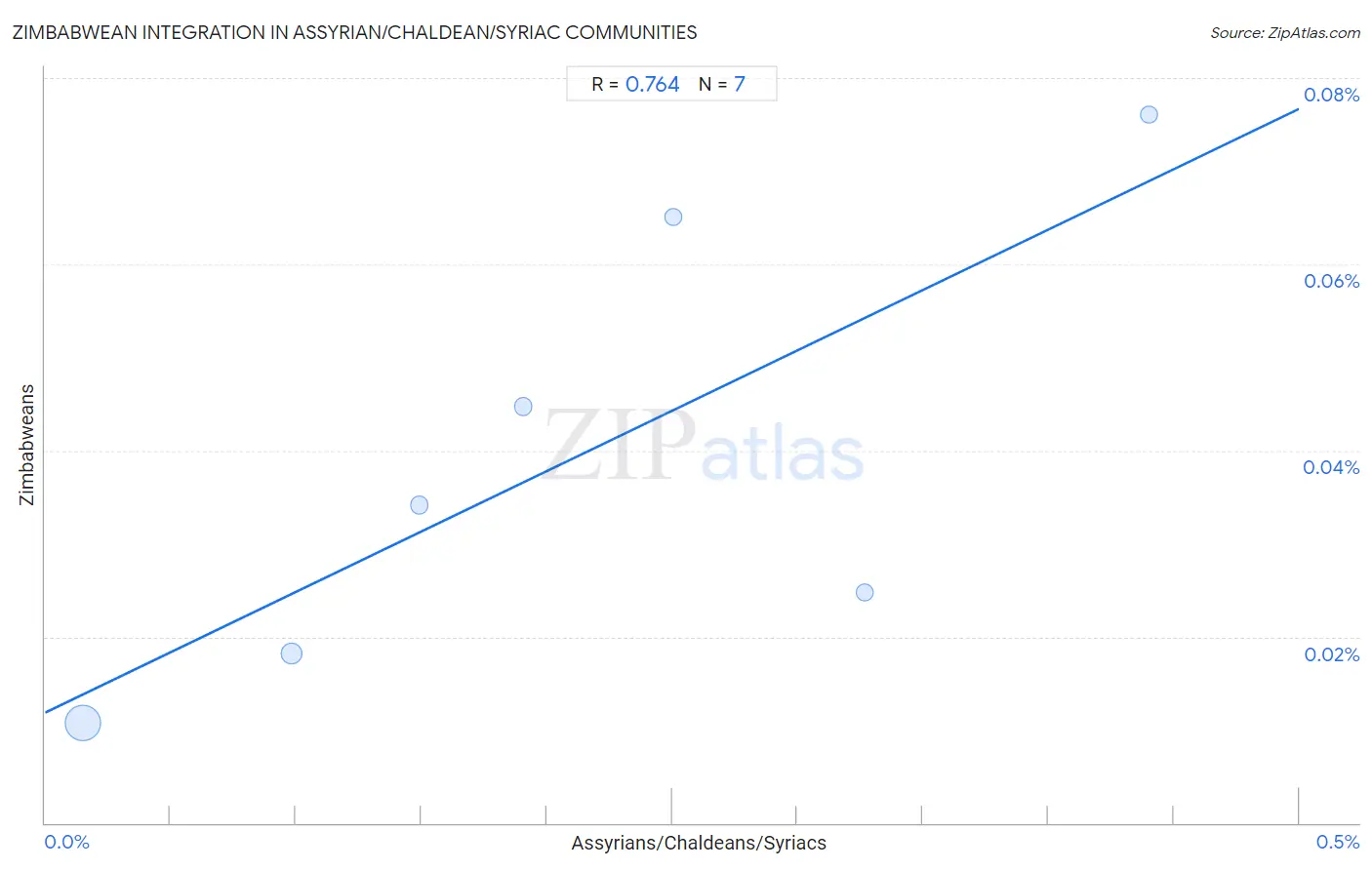
Assyrian/Chaldean/Syriac vs Zimbabwean Income
When considering income, the most significant differences between Assyrian/Chaldean/Syriac and Zimbabwean communities in the United States are seen in householder income under 25 years ($65,329 compared to $51,259, a difference of 27.5%), wage/income gap (31.0% compared to 26.3%, a difference of 17.8%), and median female earnings ($39,159 compared to $40,798, a difference of 4.2%). Conversely, both communities are more comparable in terms of median earnings ($48,304 compared to $48,229, a difference of 0.16%), median family income ($109,622 compared to $110,011, a difference of 0.35%), and per capita income ($45,195 compared to $45,804, a difference of 1.3%).

| Income Metric | Assyrian/Chaldean/Syriac | Zimbabwean |
| Per Capita Income | Excellent $45,195 | Exceptional $45,804 |
| Median Family Income | Exceptional $109,622 | Exceptional $110,011 |
| Median Household Income | Exceptional $91,991 | Exceptional $90,618 |
| Median Earnings | Exceptional $48,304 | Exceptional $48,229 |
| Median Male Earnings | Exceptional $58,437 | Excellent $56,302 |
| Median Female Earnings | Fair $39,159 | Exceptional $40,798 |
| Householder Age | Under 25 years | Exceptional $65,329 | Tragic $51,259 |
| Householder Age | 25 - 44 years | Exceptional $101,936 | Exceptional $98,586 |
| Householder Age | 45 - 64 years | Exceptional $110,201 | Exceptional $106,849 |
| Householder Age | Over 65 years | Exceptional $64,108 | Exceptional $65,854 |
| Wage/Income Gap | Tragic 31.0% | Fair 26.3% |
Assyrian/Chaldean/Syriac vs Zimbabwean Poverty
When considering poverty, the most significant differences between Assyrian/Chaldean/Syriac and Zimbabwean communities in the United States are seen in female poverty among 18-24 year olds (13.7% compared to 20.4%, a difference of 49.0%), single male poverty (9.8% compared to 13.1%, a difference of 34.2%), and single father poverty (11.7% compared to 15.6%, a difference of 32.9%). Conversely, both communities are more comparable in terms of seniors poverty over the age of 65 (9.6% compared to 9.6%, a difference of 0.32%), seniors poverty over the age of 75 (10.7% compared to 11.2%, a difference of 4.2%), and female poverty among 25-34 year olds (11.2% compared to 11.7%, a difference of 4.3%).
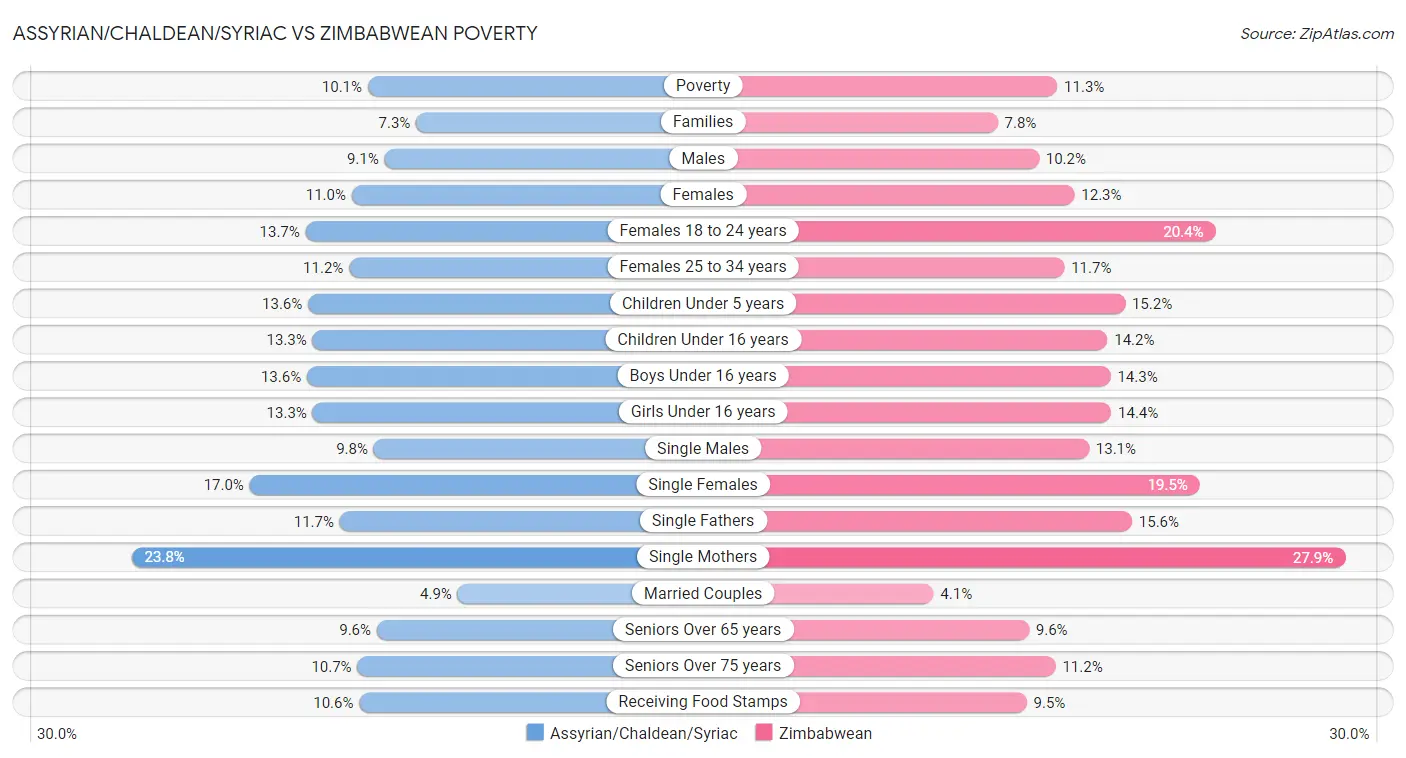
| Poverty Metric | Assyrian/Chaldean/Syriac | Zimbabwean |
| Poverty | Exceptional 10.1% | Exceptional 11.3% |
| Families | Exceptional 7.3% | Exceptional 7.8% |
| Males | Exceptional 9.1% | Exceptional 10.2% |
| Females | Exceptional 11.0% | Exceptional 12.3% |
| Females 18 to 24 years | Exceptional 13.7% | Fair 20.4% |
| Females 25 to 34 years | Exceptional 11.2% | Exceptional 11.7% |
| Children Under 5 years | Exceptional 13.6% | Exceptional 15.2% |
| Children Under 16 years | Exceptional 13.3% | Exceptional 14.2% |
| Boys Under 16 years | Exceptional 13.6% | Exceptional 14.3% |
| Girls Under 16 years | Exceptional 13.3% | Exceptional 14.4% |
| Single Males | Exceptional 9.8% | Poor 13.1% |
| Single Females | Exceptional 17.0% | Exceptional 19.5% |
| Single Fathers | Exceptional 11.7% | Exceptional 15.6% |
| Single Mothers | Exceptional 23.8% | Exceptional 27.9% |
| Married Couples | Excellent 4.9% | Exceptional 4.1% |
| Seniors Over 65 years | Exceptional 9.6% | Exceptional 9.6% |
| Seniors Over 75 years | Exceptional 10.7% | Exceptional 11.2% |
| Receiving Food Stamps | Exceptional 10.6% | Exceptional 9.5% |
Assyrian/Chaldean/Syriac vs Zimbabwean Unemployment
When considering unemployment, the most significant differences between Assyrian/Chaldean/Syriac and Zimbabwean communities in the United States are seen in unemployment among seniors over 75 years (11.1% compared to 8.7%, a difference of 26.7%), unemployment among women with children ages 6 to 17 years (7.2% compared to 8.6%, a difference of 19.9%), and female unemployment (5.6% compared to 4.8%, a difference of 17.8%). Conversely, both communities are more comparable in terms of unemployment among women with children under 18 years (5.1% compared to 5.1%, a difference of 0.020%), unemployment among ages 35 to 44 years (4.3% compared to 4.3%, a difference of 1.1%), and unemployment among ages 60 to 64 years (4.5% compared to 4.5%, a difference of 1.6%).
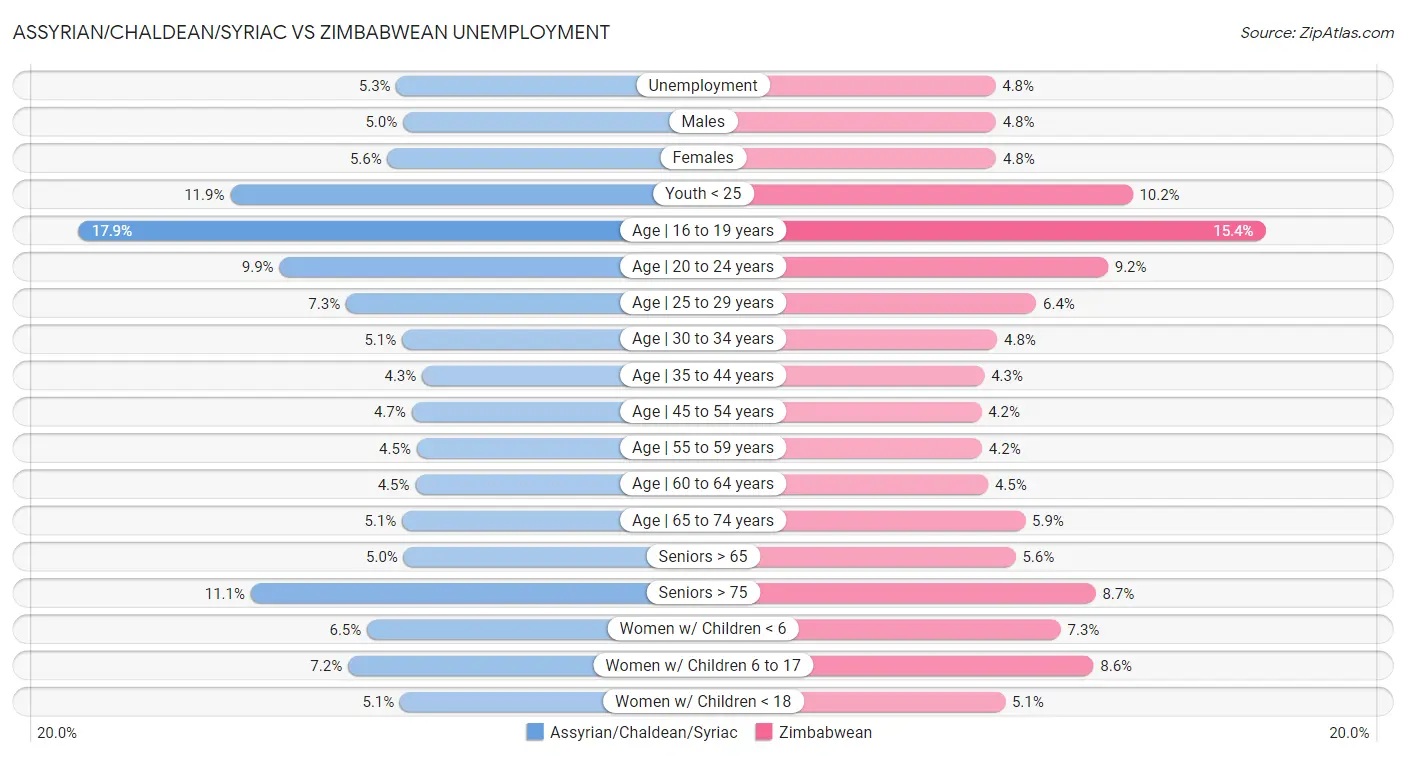
| Unemployment Metric | Assyrian/Chaldean/Syriac | Zimbabwean |
| Unemployment | Fair 5.3% | Exceptional 4.8% |
| Males | Exceptional 5.0% | Exceptional 4.8% |
| Females | Tragic 5.6% | Exceptional 4.8% |
| Youth < 25 | Tragic 11.9% | Exceptional 10.2% |
| Age | 16 to 19 years | Fair 17.9% | Exceptional 15.4% |
| Age | 20 to 24 years | Exceptional 9.9% | Exceptional 9.2% |
| Age | 25 to 29 years | Tragic 7.3% | Exceptional 6.4% |
| Age | 30 to 34 years | Exceptional 5.1% | Exceptional 4.8% |
| Age | 35 to 44 years | Exceptional 4.3% | Exceptional 4.3% |
| Age | 45 to 54 years | Tragic 4.7% | Exceptional 4.2% |
| Age | 55 to 59 years | Exceptional 4.5% | Exceptional 4.2% |
| Age | 60 to 64 years | Exceptional 4.5% | Exceptional 4.5% |
| Age | 65 to 74 years | Exceptional 5.1% | Tragic 5.9% |
| Seniors > 65 | Exceptional 5.0% | Tragic 5.6% |
| Seniors > 75 | Tragic 11.1% | Average 8.7% |
| Women w/ Children < 6 | Exceptional 6.5% | Exceptional 7.3% |
| Women w/ Children 6 to 17 | Exceptional 7.2% | Exceptional 8.6% |
| Women w/ Children < 18 | Exceptional 5.1% | Exceptional 5.1% |
Assyrian/Chaldean/Syriac vs Zimbabwean Labor Participation
When considering labor participation, the most significant differences between Assyrian/Chaldean/Syriac and Zimbabwean communities in the United States are seen in in labor force | age > 16 (64.0% compared to 67.3%, a difference of 5.1%), in labor force | age 30-34 (83.2% compared to 85.6%, a difference of 2.9%), and in labor force | age 35-44 (84.0% compared to 86.1%, a difference of 2.5%). Conversely, both communities are more comparable in terms of in labor force | age 25-29 (84.7% compared to 84.5%, a difference of 0.17%), in labor force | age 20-24 (75.9% compared to 75.6%, a difference of 0.33%), and in labor force | age 45-54 (83.2% compared to 84.0%, a difference of 1.0%).

| Labor Participation Metric | Assyrian/Chaldean/Syriac | Zimbabwean |
| In Labor Force | Age > 16 | Tragic 64.0% | Exceptional 67.3% |
| In Labor Force | Age 20-64 | Fair 79.4% | Exceptional 81.0% |
| In Labor Force | Age 16-19 | Exceptional 38.3% | Exceptional 38.7% |
| In Labor Force | Age 20-24 | Exceptional 75.9% | Excellent 75.6% |
| In Labor Force | Age 25-29 | Average 84.7% | Fair 84.5% |
| In Labor Force | Age 30-34 | Tragic 83.2% | Exceptional 85.6% |
| In Labor Force | Age 35-44 | Tragic 84.0% | Exceptional 86.1% |
| In Labor Force | Age 45-54 | Exceptional 83.2% | Exceptional 84.0% |
Assyrian/Chaldean/Syriac vs Zimbabwean Family Structure
When considering family structure, the most significant differences between Assyrian/Chaldean/Syriac and Zimbabwean communities in the United States are seen in births to unmarried women (22.0% compared to 28.7%, a difference of 30.6%), single mother households (4.8% compared to 6.1%, a difference of 26.1%), and single father households (2.0% compared to 2.2%, a difference of 12.8%). Conversely, both communities are more comparable in terms of family households with children (28.1% compared to 27.9%, a difference of 0.68%), average family size (3.24 compared to 3.20, a difference of 1.4%), and family households (68.2% compared to 64.1%, a difference of 6.4%).

| Family Structure Metric | Assyrian/Chaldean/Syriac | Zimbabwean |
| Family Households | Exceptional 68.2% | Fair 64.1% |
| Family Households with Children | Exceptional 28.1% | Exceptional 27.9% |
| Married-couple Households | Exceptional 51.8% | Excellent 47.4% |
| Average Family Size | Good 3.24 | Poor 3.20 |
| Single Father Households | Exceptional 2.0% | Exceptional 2.2% |
| Single Mother Households | Exceptional 4.8% | Excellent 6.1% |
| Currently Married | Exceptional 50.8% | Good 47.0% |
| Divorced or Separated | Exceptional 10.6% | Exceptional 11.6% |
| Births to Unmarried Women | Exceptional 22.0% | Exceptional 28.7% |
Assyrian/Chaldean/Syriac vs Zimbabwean Vehicle Availability
When considering vehicle availability, the most significant differences between Assyrian/Chaldean/Syriac and Zimbabwean communities in the United States are seen in no vehicles in household (7.0% compared to 9.0%, a difference of 29.5%), 4 or more vehicles in household (7.2% compared to 6.4%, a difference of 11.1%), and 3 or more vehicles in household (21.7% compared to 20.3%, a difference of 7.2%). Conversely, both communities are more comparable in terms of 1 or more vehicles in household (93.0% compared to 91.0%, a difference of 2.2%), 2 or more vehicles in household (60.5% compared to 57.2%, a difference of 5.8%), and 3 or more vehicles in household (21.7% compared to 20.3%, a difference of 7.2%).

| Vehicle Availability Metric | Assyrian/Chaldean/Syriac | Zimbabwean |
| No Vehicles Available | Exceptional 7.0% | Exceptional 9.0% |
| 1+ Vehicles Available | Exceptional 93.0% | Exceptional 91.0% |
| 2+ Vehicles Available | Exceptional 60.5% | Exceptional 57.2% |
| 3+ Vehicles Available | Exceptional 21.7% | Excellent 20.3% |
| 4+ Vehicles Available | Exceptional 7.2% | Good 6.4% |
Assyrian/Chaldean/Syriac vs Zimbabwean Education Level
When considering education level, the most significant differences between Assyrian/Chaldean/Syriac and Zimbabwean communities in the United States are seen in no schooling completed (2.5% compared to 1.7%, a difference of 41.9%), doctorate degree (1.7% compared to 2.3%, a difference of 37.5%), and professional degree (4.5% compared to 5.2%, a difference of 14.9%). Conversely, both communities are more comparable in terms of 4th grade (97.2% compared to 97.9%, a difference of 0.75%), nursery school (97.6% compared to 98.3%, a difference of 0.76%), and kindergarten (97.5% compared to 98.3%, a difference of 0.76%).
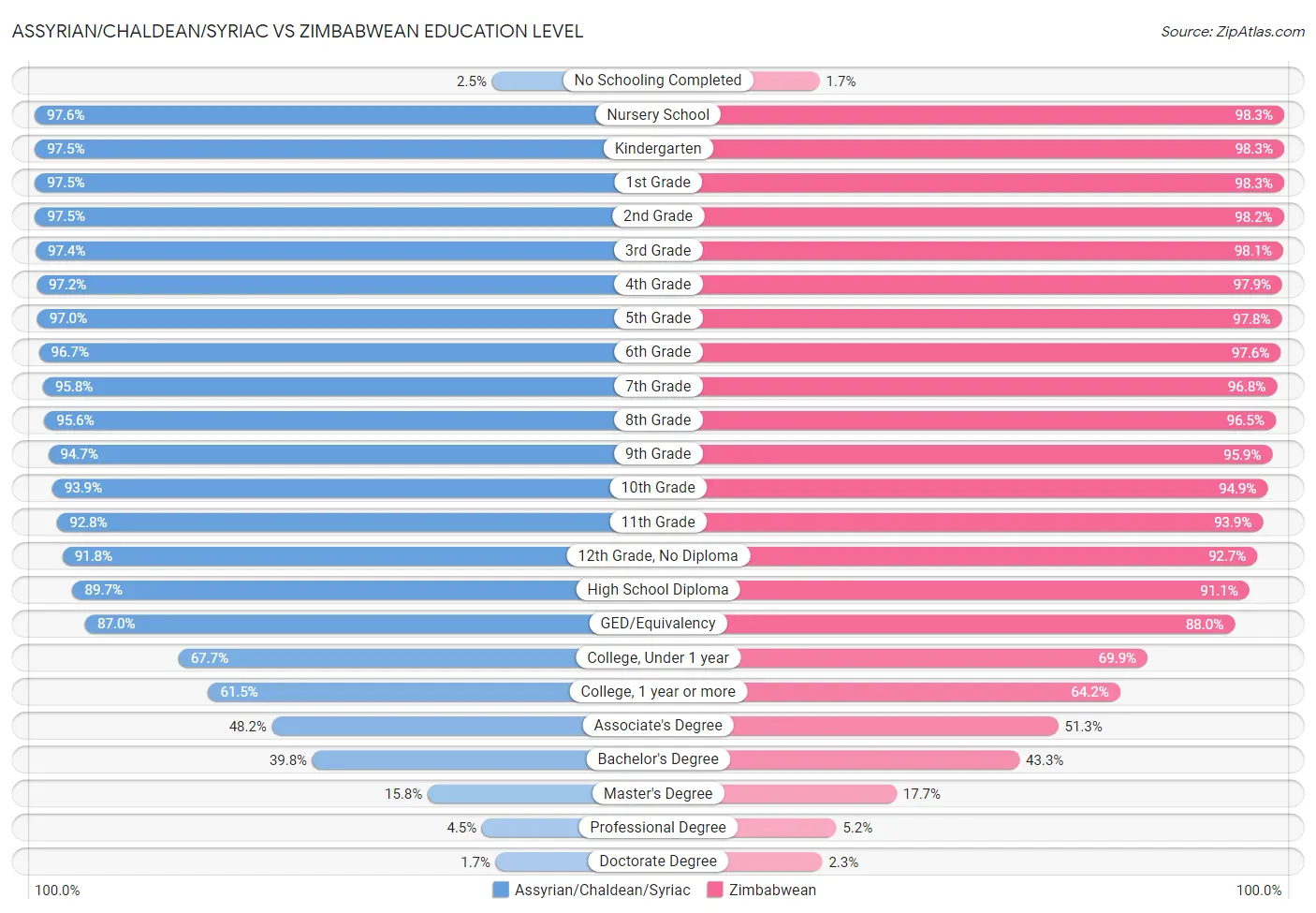
| Education Level Metric | Assyrian/Chaldean/Syriac | Zimbabwean |
| No Schooling Completed | Tragic 2.5% | Exceptional 1.7% |
| Nursery School | Tragic 97.6% | Exceptional 98.3% |
| Kindergarten | Tragic 97.5% | Exceptional 98.3% |
| 1st Grade | Tragic 97.5% | Exceptional 98.3% |
| 2nd Grade | Tragic 97.5% | Exceptional 98.2% |
| 3rd Grade | Tragic 97.4% | Exceptional 98.1% |
| 4th Grade | Tragic 97.2% | Exceptional 97.9% |
| 5th Grade | Tragic 97.0% | Exceptional 97.8% |
| 6th Grade | Tragic 96.7% | Exceptional 97.6% |
| 7th Grade | Fair 95.8% | Exceptional 96.8% |
| 8th Grade | Fair 95.6% | Exceptional 96.5% |
| 9th Grade | Fair 94.7% | Exceptional 95.9% |
| 10th Grade | Good 93.9% | Exceptional 94.9% |
| 11th Grade | Excellent 92.8% | Exceptional 93.9% |
| 12th Grade, No Diploma | Excellent 91.8% | Exceptional 92.7% |
| High School Diploma | Excellent 89.7% | Exceptional 91.1% |
| GED/Equivalency | Exceptional 87.0% | Exceptional 88.0% |
| College, Under 1 year | Exceptional 67.7% | Exceptional 69.9% |
| College, 1 year or more | Exceptional 61.5% | Exceptional 64.2% |
| Associate's Degree | Excellent 48.2% | Exceptional 51.3% |
| Bachelor's Degree | Excellent 39.8% | Exceptional 43.3% |
| Master's Degree | Excellent 15.8% | Exceptional 17.7% |
| Professional Degree | Good 4.5% | Exceptional 5.2% |
| Doctorate Degree | Tragic 1.7% | Exceptional 2.3% |
Assyrian/Chaldean/Syriac vs Zimbabwean Disability
When considering disability, the most significant differences between Assyrian/Chaldean/Syriac and Zimbabwean communities in the United States are seen in self-care disability (2.8% compared to 2.2%, a difference of 32.5%), ambulatory disability (6.4% compared to 5.4%, a difference of 19.0%), and hearing disability (3.3% compared to 2.8%, a difference of 17.0%). Conversely, both communities are more comparable in terms of disability age 35 to 64 (10.5% compared to 10.4%, a difference of 0.45%), disability age over 75 (49.1% compared to 48.1%, a difference of 2.1%), and vision disability (2.0% compared to 2.0%, a difference of 3.6%).
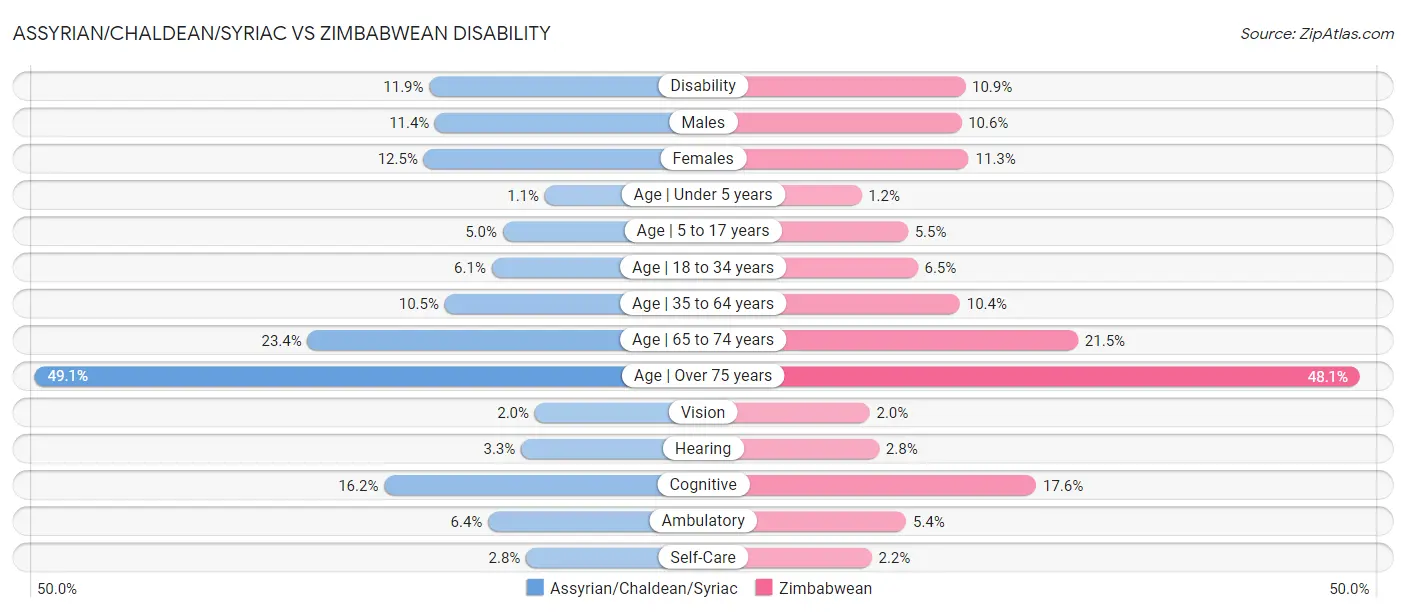
| Disability Metric | Assyrian/Chaldean/Syriac | Zimbabwean |
| Disability | Poor 11.9% | Exceptional 10.9% |
| Males | Fair 11.4% | Exceptional 10.6% |
| Females | Tragic 12.5% | Exceptional 11.3% |
| Age | Under 5 years | Exceptional 1.1% | Exceptional 1.2% |
| Age | 5 to 17 years | Exceptional 5.0% | Good 5.5% |
| Age | 18 to 34 years | Exceptional 6.1% | Good 6.5% |
| Age | 35 to 64 years | Exceptional 10.5% | Exceptional 10.4% |
| Age | 65 to 74 years | Average 23.4% | Exceptional 21.5% |
| Age | Over 75 years | Tragic 49.1% | Tragic 48.1% |
| Vision | Exceptional 2.0% | Exceptional 2.0% |
| Hearing | Tragic 3.3% | Excellent 2.8% |
| Cognitive | Exceptional 16.2% | Tragic 17.6% |
| Ambulatory | Tragic 6.4% | Exceptional 5.4% |
| Self-Care | Tragic 2.8% | Exceptional 2.2% |